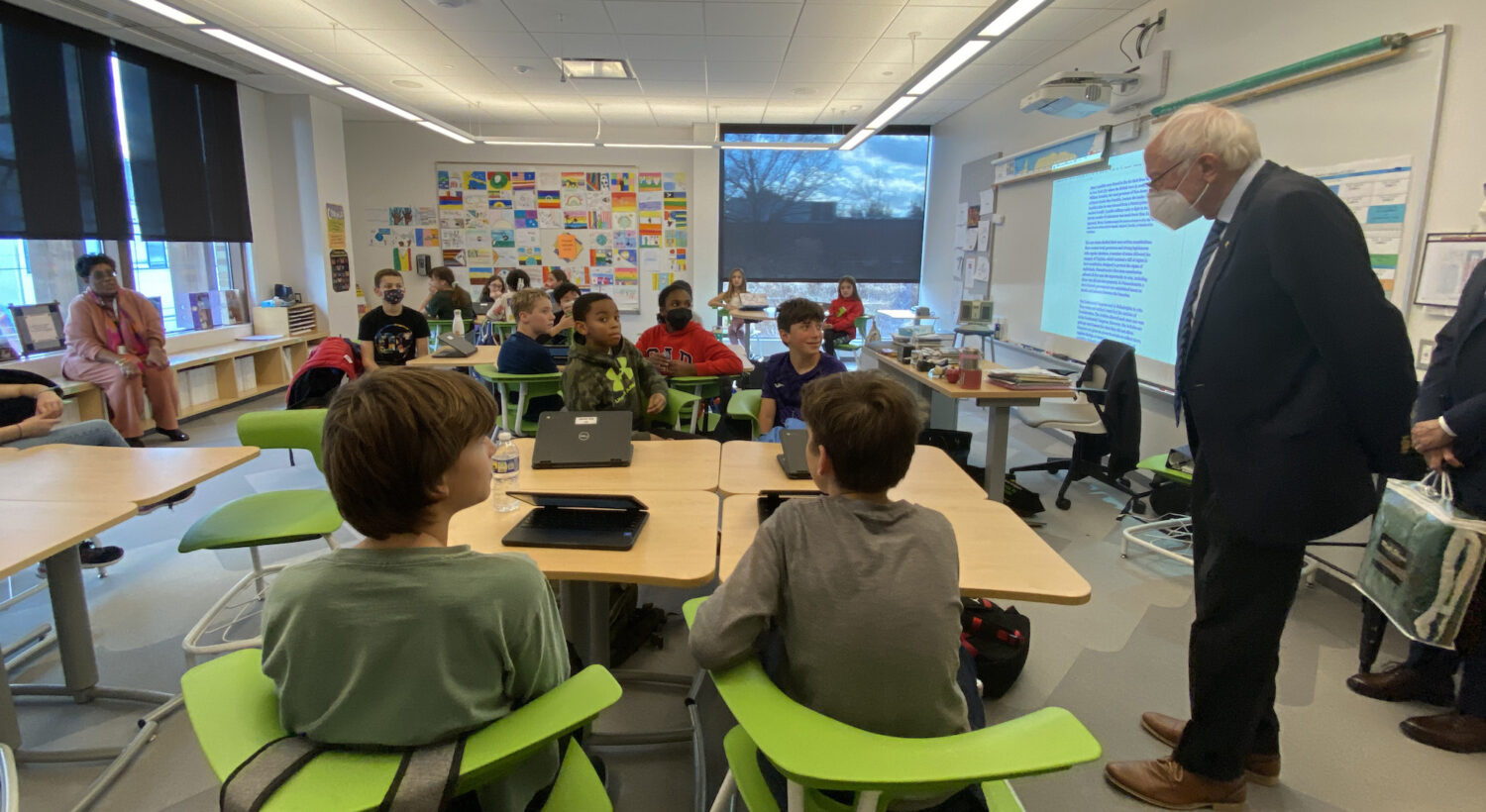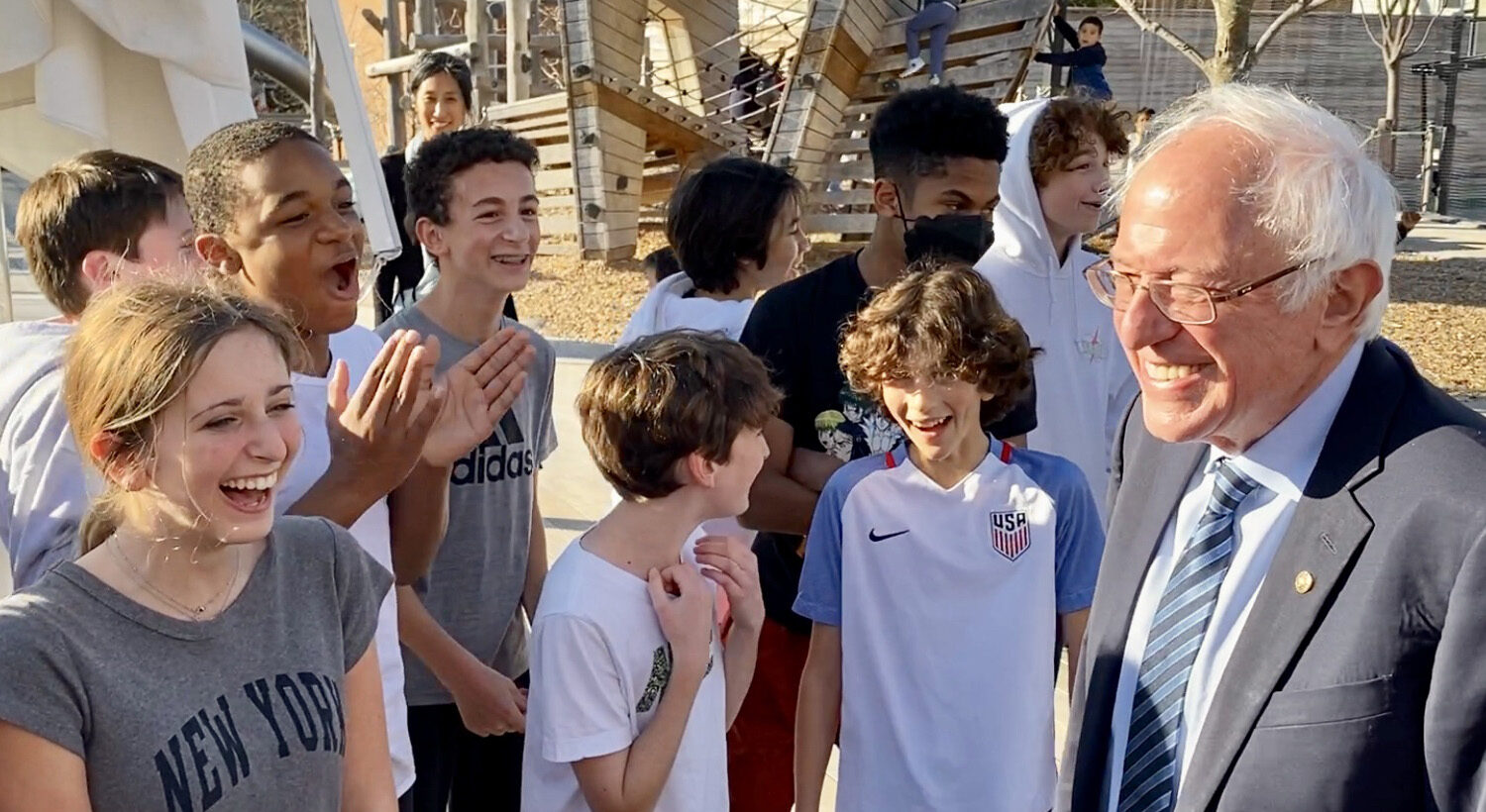Meg’s Minutes: A Teaching-in-Practice Series
As part of her process for getting to know GDS during her first year as Associate Head of School, Meg Goldner Rabinowitz has been visiting classrooms to learn first-hand about the excellent teaching and learning for which our School is known. In this series, she shares some of her reflections—through her lens as an educator and school leader—as a sort of annotated glimpse into life and learning at GDS.
There is a lot I could say about last week’s visit from Senator Bernie Sanders’, Chair of the Health, Education, Labor, and Pensions Committee. He spent the afternoon visiting Georgetown Day School’s campus. I could talk about his warmth and accessibility. I could talk about his flexible and inquisitive nature. I could talk about what a mensch he was toward everyone with whom he interacted. But what I want to focus on, in the spirit of reflective practice, is how much the purpose and power of his visit echoed and mirrored what took place at the heart of one of the classrooms he visited. As one of many tours of educational settings, after-school programs, and summer camps, Sanders’ visit to GDS was to see what was going on in our classes, think about questions that arise as he toured the campus, and wonder about what it means for educational trends more broadly.
The first welcoming stop on our tour was Judy Brown’s fifth grade class, where students were talking about life for the average American in the post-American Revolution era. We then moved to Bryan Williams’s math class where students were designing their own flags on the xy quadrants of a page. Students were engaged and focused on their individual work while the desks were grouped in clusters. No rows of desks in this math class, Senator Sanders observed. Bryan moved around the room providing support and encouragement. We briefly stepped into Jon Vanegas’s exciting and energetic sixth grade science class, where students shared their recent studies of the planets and designed aliens that could survive on their assigned planets. Our tour also included a visit to the PK classroom, the playground, and the chorus room.
Our longest classroom visit took place in Kate Maloney’s history classroom, where several extraordinary moments occurred. Kate’s lesson on Ancient Egypt was constructed around Harvard University’s Project Zero curriculum design thinking. Core to this are three organizing principles: See, Think, and Wonder.
When I spoke with Kate after the class to hear about the framing of her lesson, she shared that her goal was to help make students’ critical thinking visible to others in order to facilitate dialogue and deepen student learning and understanding. Project Zero is a Middle School History department-wide initiative that grew out of a professional development several years ago hosted by the Washington International School. All our History teachers were trained at the time and they have consistently onboarded new faculty to the shared philosophy.
Kate described to me that the purpose of the specific lesson we observed was to work on historical thinking skills by focusing on a visual that encapsulated social structures and equity in the Ancient world. The intentionality behind beginning with a visual was to provide the most accessible way into the lesson.“This is a way to capture their interest and imagination,” according to Kate.
Step one of Kate’s exercise: See. Kate instructed her students to write down everything they observed from the visual. Kate described to me that the “Seeing” part of the exercise encourages several goals. One, it builds community and discussion, allowing students to see things from new perspectives. Second, seeing allows the pace of class to slow down, which in turn encourages deeper thinking. Kate encourages students to elaborate on their perspectives by posing the question, “What makes you say that?”
Step two: Think. Senator Sanders and I stepped into the room when students were detecting patterns in the visual, offering interpretations and explanations. Students responded to ideas that resonated with their own, and also expressed appreciation when someone raised an idea they had not considered. Kate asked, “Are you seeing things differently now?”
Step three: Wonder. While we observed, a beautiful highlight reel-moment occurred. This is the kind of moment that brings teachers back to the classroom year after year. As a teacher, you can develop a vibrant curriculum and create a safe classroom, but the true magic of learning happens when students lead the way. A student raised her hand and observed, “I remember when we talked about this other primary source and we made similar observations,” connecting her current learning to her prior learning in a deep and meaningful way. There was a shared sense of mutual revelation from her classmates and a look of genuine awe from Kate.
This is the kind of moment that brings teachers back to the classroom year after year. Teachers can develop a vibrant curriculum and create a safe classroom, but the true magic of learning happens when students lead the way.
When I spoke with Kate, what she said she loved about that moment, and the others that were exhibited in the “Wonder” portion of the exercise, was the way students were building on each other’s ideas, the way that they were comfortable with not knowing everything, the way that they were empowered to think that their observations and thinking processes were each important, and the way that as a collective, they built a deeper and more profound shared understanding.
See, think, wonder. These terms are a beautiful summary of the purpose and outcome of Senator Sanders’ visit to GDS. I feel so fortunate to have been able to meet the Senator, but more so to have had the chance to step into our classrooms and see the powerful learning that occurs from the perspective of visitors who were filled with wonder and appreciation for our approach to teaching and learning.





